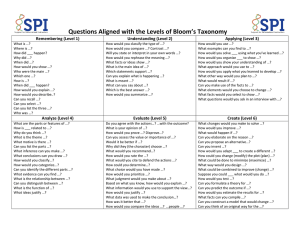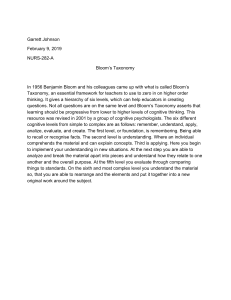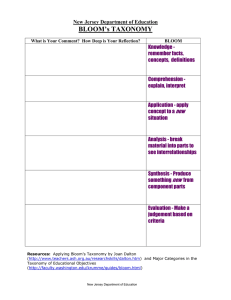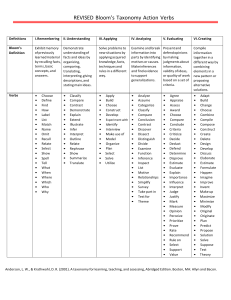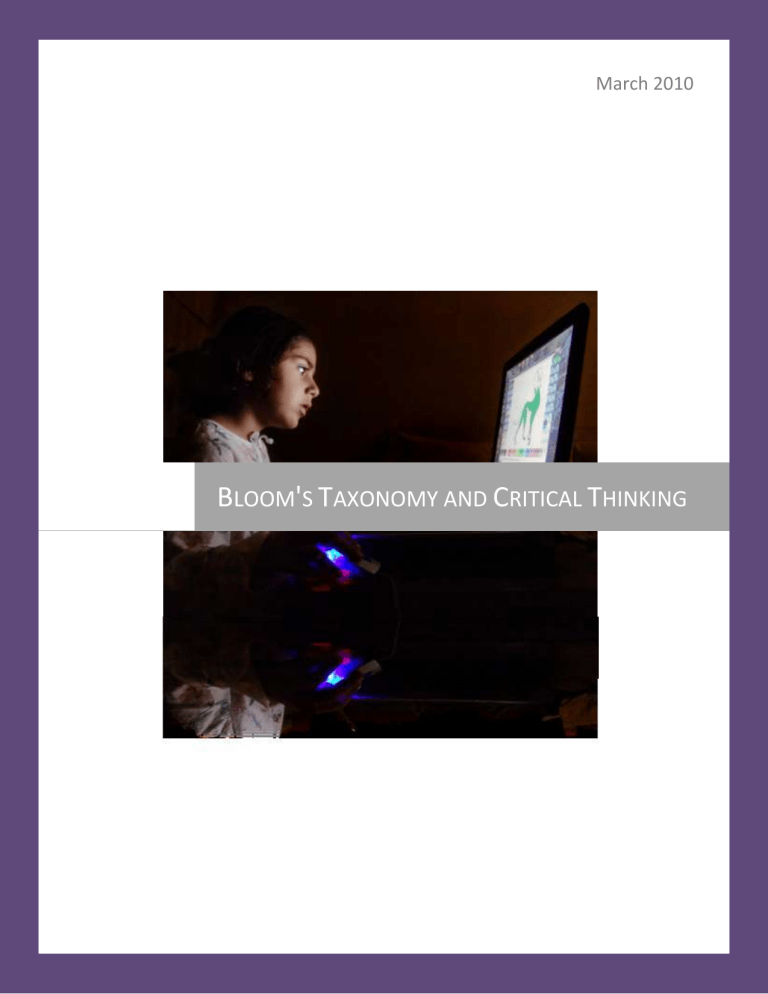
March 2010 BLOOM'S TAXONOMY AND CRITICAL THINKING Page 2 of 7 Critical Thinking across the Curriculum Contents Bloom's Taxonomy and Critical Thinking ..................................................................................................3 Bloom’s in a group ICT project - ............................................................................................................4 Learning objective profile .....................................................................................................................4 Questioning for pupil evidence .................................................................................................................5 Level 1: Knowledge ...............................................................................................................................5 Level 2: Comprehension........................................................................................................................5 Level 3: Application ...............................................................................................................................5 Level 4: Analysis ....................................................................................................................................6 Level 5: Synthesis ..................................................................................................................................6 Level 6: Evaluation ................................................................................................................................7 Table of figures Figure 1: Selected cognitive and affective categories of Bloom's Taxonomy............................. 3 Figure 2: Group ICT project learning objectives provided by course teacher ............................. 4 Figure 3: Learning objective profile for the group ICT system project ....................................... 4 Bloom's Critical Thinking Across the Curriculum2 Jul-10 Page 3 of 7 Bloom's Taxonomy and Critical Thinking Thinking skills enable pupils to turn their experience into learning. We need to focus on ‘knowing how’, rather than ‘knowing what’: learning how to learn. They are the foundation of personal development as well as making an important contribution to social and economic development by helping to develop students who have the capacity to think and act creatively, to meet challenges positively and effectively, and show initiative and enterprise in how they think and learn. Robert Fisher ( ) Bloom's Taxonomy divides the way people learn into three domains. One of these is the cognitive domain which emphasizes intellectual outcomes. This domain is further divided into categories or levels. The key words used and the type of questions asked may aid in the establishment and encouragement of critical thinking, especially in the higher levels. Cognitive Domain Category Knowledge Comprehension Application Analysis Synthesis Evaluation Description Remembering previously learned information Grasping the meaning of information Applying knowledge to actual situations Breaking down objects or ideas into simpler parts and seeing how the parts relate and are organised Rearranging component ideas into a new whole Making judgements based on internal evidence or external criteria Affective Domain Category Valuation Description That a thing, phenomenon, or behaviour has worth Figure 1: Selected cognitive and affective categories of Bloom's Taxonomy Bloom's Critical Thinking Across the Curriculum2 Jul-10 Page 4 of 7 Bloom’s in a group ICT project – Learning objectives for an ICT project Work in teams Analyse users and purpose including data Define functional requirements and constraints imposed on the design Perform design component testing and analyse the results Use the results during brainstorming Identify at least three possible system designs during brainstorming Choose one of the designs by using arguments based on knowledge gained during component testing, general knowledge of ICT systems and by general observations of existing similar systems (whether ICT or not) Build and test the prototype Refine or redesign Build and test the final design. Evaluate it against your original analysis Present the design to the other teams Write a report describing the design and possibly a user guide Figure 2: Project learning objectives provided by course teacher uat ion Val Eva lua tion is Syn th e s Ana lysi s App lica tion Com pr e hen s Kno w le dge ion Learning objective profile Need recognition Problem definition Planning Management Information gathering Ideas generation Modeling Feasibility analysis Evaluation Selection/decision Implementation Communication Documentation Iteration Figure 3: Learning objective profile for the group ICT system project Bloom's Critical Thinking Across the Curriculum2 Jul-10 Page 5 of 7 Questioning for pupil evidence Level 1: Knowledge - exhibits previously learned material by recalling facts, terms, basic concepts and answers. Key words: who, what, why, when, omit, where, which, choose, find, how, define, label, show, spell, list, match, name, relate, tell, recall, select Questions: What is . . . ? How is . . . ? Where is . . . ? When did _______ happen? How did ______ happen? How would you explain . . . ? Why did . . . ? How would you describe . . . ? When did . . . ? Can you recall . . . ? How would you show . . . ? Can you select . . . ? Who were the main . . . ? Can you list three . . . ? Which one . . . ? Who was . . . ? Level 2: Comprehension - demonstrating understanding of facts and ideas by organizing, comparing, translating, interpreting, giving descriptions and stating main ideas. Key words: compare, contrast, demonstrate, interpret, explain, extend, illustrate, infer, outline, relate, rephrase, translate, summarize, show, classify Questions: How would you classify the type of . . . ? How would you compare . . . ? contrast . . . ? Will you state or interpret in your own words . . . ? How would you rephrase the meaning . . . ? What facts or ideas show . . . ? What is the main idea of . . . ? Which statements support . . . ? Can you explain what is happening . . . what is meant . . .? What can you say about . . . ? Which is the best answer . . . ? How would you summarize . . . ? Level 3: Application - solving problems by applying acquired knowledge, facts, techniques and rules in a different way. Key words: apply, build, choose, construct, develop, interview, make use of, organize, experiment with, plan, select, solve, utilize, model, identify Questions: How would you use . . . ? What examples can you find to . . . ? How would you solve _______ using what you have learned . . . ? How would you organize _______ to show . . . ? How would you show your understanding of . . . ? What approach would you use to . . . ? How would you apply what you learned to develop . . . ? Bloom's Critical Thinking Across the Curriculum2 Jul-10 Page 6 of 7 What other way would you plan to . . . ? What would result if . . . ? Can you make use of the facts to . . . ? What elements would you choose to change . . . ? What facts would you select to show . . . ? What questions would you ask in an interview with . . . ? Level 4: Analysis - examining and breaking information into parts by identifying motives or causes; making inferences and finding evidence to support generalizations. Key words: analyze, categorize, classify, compare, contrast, discover, dissect, divide, examine, inspect, simplify, survey, take part in, test for, distinguish, list, distinction, theme, relationships, function, motive, inference, assumption, conclusion Questions: What are the parts or features of . . . ? How is _______ related to . . . ? Why do you think . . . ? What is the theme . . . ? What motive is there . . . ? Can you list the parts . . . ? What inference can you make . . . ? What conclusions can you draw . . . ? How would you classify . . . ? How would you categorize . . . ? Can you identify the difference parts . . . ? What evidence can you find . . . ? What is the relationship between . . . ? Can you make a distinction between . . . ? What is the function of . . . ? What ideas justify . . . ? Level 5: Synthesis - compiling information together in a different way by combining elements in a new pattern or proposing alternative solutions. Key Words: build, choose, combine, compile, compose, construct, create, design, develop, estimate, formulate, imagine, invent, make up, originate, plan, predict, propose, solve, solution, suppose, discuss, modify, change, original, improve, adapt, minimize, maximize, delete, theorize, elaborate, test, improve, happen, change Questions: What changes would you make to solve . . . ? How would you improve . . . ? What would happen if . . . ? Can you elaborate on the reason . . . ? Can you propose an alternative . . . ? Can you invent . . . ? Bloom's Critical Thinking Across the Curriculum2 Jul-10 Page 7 of 7 How would you adapt ________ to create a different . . . ? How could you change (modify) the plot (plan) . . . ? What could be done to minimize (maximize) . . . ? What way would you design . . . ? What could be combined to improve (change) . . . ? Suppose you could _______ what would you do . . . ? How would you test . . . ? Can you formulate a theory for . . . ? Can you predict the outcome if . . . ? How would you estimate the results for . . . ? What facts can you compile . . . ? Can you construct a model that would change . . . ? Can you think of an original way for the . . . ? Level 6: Evaluation - presenting and defending opinions by making judgments about information, validity of ideas or quality of work based on a set of criteria. Key Words: award, choose, conclude, criticize, decide, defend, determine, dispute, evaluate, judge, justify, measure, compare, mark, rate, recommend, rule on, select, agree, interpret, explain, appraise, prioritize, opinion, ,support, importance, criteria, prove, disprove, assess, influence, perceive, value, estimate, influence, deduct Questions: Do you agree with the actions . . . ? with the outcomes . . . ? What is your opinion of . . . ? How would you prove . . . ? disprove . . . ? Can you assess the value or importance of . . . ? Would it be better if . . . ? Why did they (the character) choose . . . ? What would you recommend . . . ? How would you rate the . . . ? What would you cite to defend the actions . . . ? How would you evaluate . . . ? How could you determine . . . ? What choice would you have made . . . ? What would you select . . . ? How would you prioritize . . . ? What judgment would you make about . . . ? Based on what you know, how would you explain . . . ? What information would you use to support the view . . . ? How would you justify . . . ? What data was used to make the conclusion . . . ? Why was it better that . . . ? How would you prioritize the facts . . . ? How would you compare the ideas . . . ? people . . . ? Bloom's Critical Thinking Across the Curriculum2 Jul-10
